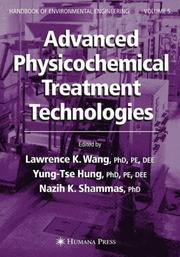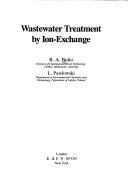| Listing 1 - 10 of 121 | << page >> |
Sort by
|
Book
ISBN: 1282578138 9786612578137 1552504662 Year: 2010 Publisher: Rugby, Warwickshire : Ottawa : Practical Action Pub. ; International Development Research Centre,
Abstract | Keywords | Export | Availability | Bookmark
 Loading...
Loading...Choose an application
- Reference Manager
- EndNote
- RefWorks (Direct export to RefWorks)
In water-scarce areas of the Middle East, greywater (household wastewater excluding toilet waste) is commonly used by poor communities to irrigate home gardens. This both supplements the water available to the household and improves food security. This book draws together material presented at a conference in Jordan in 2007, and examines the technical approaches to treating and using greywater for irrigation, including its associated risks to health and the environment. It discusses many of the non-technical issues that influence effectiveness and sustainability of greywater use. It also takes
Book
ISBN: 0309388384 0309388368 Year: 2016 Publisher: Washington, District of Columbia : The National Academies Press,
Abstract | Keywords | Export | Availability | Bookmark
 Loading...
Loading...Choose an application
- Reference Manager
- EndNote
- RefWorks (Direct export to RefWorks)
"Chronic and episodic water shortages are becoming common in many regions of the United States, and population growth in water-scarce regions further compounds the challenges. Increasingly, alternative water sources such as graywater-untreated wastewater that does not include water from the toilet but generally includes water from bathroom sinks, showers, bathtubs, clothes washers, and laundry sinks- and stormwater-water from rainfall or snow that can be measured downstream in a pipe, culvert, or stream shortly after the precipitation event-are being viewed as resources to supplement scarce water supplies rather than as waste to be discharged as rapidly as possible. Graywater and stormwater can serve a range of non-potable uses, including irrigation, toilet flushing, washing, and cooling, although treatment may be needed. Stormwater may also be used to recharge groundwater, which may ultimately be tapped for potable use. In addition to providing additional sources of local water supply, harvesting stormwater has many potential benefits, including energy savings, pollution prevention, and reducing the impacts of urban development on urban streams. Similarly, the reuse of graywater can enhance water supply reliability and extend the capacity of existing wastewater systems in growing cities. Despite the benefits of using local alternative water sources to address water demands, many questions remain that have limited the broader application of graywater and stormwater capture and use. In particular, limited information is available on the costs, benefits, and risks of these projects, and beyond the simplest applications many state and local public health agencies have not developed regulatory frameworks for full use of these local water resources. To address these issues, Using Graywater and Stormwater to Enhance Local Water Supplies analyzes the risks, costs, and benefits on various uses of graywater and stormwater. This report examines technical, economic, regulatory, and social issues associated with graywater and stormwater capture for a range of uses, including non-potable urban uses, irrigation, and groundwater recharge. Using Graywater and Stormwater to Enhance Local Water Supplies considers the quality and suitability of water for reuse, treatment and storage technologies, and human health and environmental risks of water reuse. The findings and recommendations of this report will be valuable for water managers, citizens of states under a current drought, and local and state health and environmental agencies"--Publisher description.
Water reuse --- Graywater (Domestic wastewater) --- Runoff --- Management. --- Management. --- Management.
Book
ISBN: 1780440227 Year: 2010 Publisher: Warwickshire, England ; Ottawa, Ontario : Practical Action Publishing : International Development Research Centre,
Abstract | Keywords | Export | Availability | Bookmark
 Loading...
Loading...Choose an application
- Reference Manager
- EndNote
- RefWorks (Direct export to RefWorks)
Sewage irrigation --- Water reuse --- Graywater (Domestic wastewater) --- Recycling
Book
ISBN: 1601387741 9781601387745 Year: 2012 Publisher: Ocala, Fla : Atlantic Publishing Group. Inc.,
Abstract | Keywords | Export | Availability | Bookmark
 Loading...
Loading...Choose an application
- Reference Manager
- EndNote
- RefWorks (Direct export to RefWorks)
Water is the most important natural resource in your life you use it to drink, water your lawn, clean yourself, your dishes, and your clothes, and to cook. Nothing can be done in life without water, and yet if an emergency occurs, the Federal Emergency Management Agency estimates that nearly 4 in 5 Americans would be without access to clean water if a major disaster disrupted or contaminated their public water supply. It is for this reason that many individuals have looked into the possibility of utilizing tanks, ponds, and other means of water storage to maintain a safe, viable source of drinking water for them and their families in the case of an emergency. This book will guide you through the process of learning more about these potential lifesaving water storage methods, the legal implications, and the financial aspects of storing your own water for future. You will learn all of the basic design principles of water storage as well as how water quality is measured and maintained while in storage. Water purification and construction experts have been interviewed for this book and their insights have been added to provide you with every possible outlook and detail you might need to effectively store your water. You will learn the necessary aspects of tank roofs, the costs, footings, floorings, designs, and most importantly your local regulations regarding storage of water on your property. For every possible water storage solution you might be considering, this book will cover every aspect.
Water reuse --- Water --- Water harvesting --- Graywater (Domestic wastewater) --- Graywater (Domestic wastewater) -- Recycling. --- Water -- Storage. --- Water harvesting. --- Water reuse. --- Storage --- Recycling
Book
Year: 2010 Publisher: [Reston, Va.] : U.S. Dept. of the Interior, U.S. Geological Survey,
Abstract | Keywords | Export | Availability | Bookmark
 Loading...
Loading...Choose an application
- Reference Manager
- EndNote
- RefWorks (Direct export to RefWorks)

ISBN: 1280832533 9786610832538 1597451738 1588298604 Year: 2007 Publisher: Totowa, N.J. : Humana Press,
Abstract | Keywords | Export | Availability | Bookmark
 Loading...
Loading...Choose an application
- Reference Manager
- EndNote
- RefWorks (Direct export to RefWorks)
In Advanced Physiochemical Treatment Technologies, leading pollution control educators and practicing professionals describe how various combinations of different cutting-edge process systems can be arranged to solve air, noise, and thermal pollution problems. Each chapter discusses in detail the three basic forms in which pollutants and waste are manifested: gas, solid, and liquid.
Sewage --- Water --- Purification --- Technological innovations. --- Hydrology --- Domestic effluent --- Domestic sewage --- Domestic wastewater --- Effluent (Sewage) --- Industrial effluent --- Industrial wastewater --- Sewage effluent --- Waste water --- Waste waters --- Wastewater --- Wastewaters --- Sewerage
Book
ISBN: 1789234778 178923476X 1838814876 Year: 2018 Publisher: IntechOpen
Abstract | Keywords | Export | Availability | Bookmark
 Loading...
Loading...Choose an application
- Reference Manager
- EndNote
- RefWorks (Direct export to RefWorks)
Wastewater treatment and sludge disposal are important for protecting receiving rivers, lakes, and other water bodies, and vital for human health. Since excessive discharge may cause eutrophication and deterioration of aquatic systems, the US EPA and other national agencies have set guidelines for wastewater discharge standards. Conventional technologies are well developed and widely applied worldwide for wastewater treatment; however, new ideas and new technologies are gaining additional interest for the sake of water and energy reuse. While water is essential in arid regions, wastewater reuse and recycling have been playing an important role in human life. Although there are no universal standards for industrial and agriculture reuse, balancing wastewater treatment and public health protection presents challenges and opportunities.
Sewage. --- Domestic effluent --- Domestic sewage --- Domestic wastewater --- Effluent (Sewage) --- Industrial effluent --- Industrial wastewater --- Sewage effluent --- Waste water --- Waste waters --- Wastewater --- Wastewaters --- Sewerage --- Life Sciences --- Waste Management --- Environmental Sciences
Book
ISBN: 0323900119 0323855830 9780323900119 9780323855839 Year: 2022 Publisher: Amsterdam, Netherlands ; Oxford, England ; Cambridge, Massachusetts : Elsevier,
Abstract | Keywords | Export | Availability | Bookmark
 Loading...
Loading...Choose an application
- Reference Manager
- EndNote
- RefWorks (Direct export to RefWorks)
"Development in Wastewater Treatment Research and Processes: Microbial Degradation of Xenobiotics through Bacterial and Fungal Approach covers the active and applicable role that bacteria and fungi play in the degradation of xenobiotic compounds from the environment. The book gives up-to-date information on recent advancements in the field of environmental xenobiotics and how they disturb a plant's metabolism. The book also gives information on aerobic and anaerobic degradation of xenobiotic compounds through bacteria or fungi and/or a combined approach. Finally, the book covers the characteristics of environmental microbiology, biochemical engineering, agricultural microbiology, environmental engineering, and soil bioremediation"--
Sewage --- Purification --- Technological innovations. --- Domestic effluent --- Domestic sewage --- Domestic wastewater --- Effluent (Sewage) --- Industrial effluent --- Industrial wastewater --- Sewage effluent --- Waste water --- Waste waters --- Wastewater --- Wastewaters --- Sewerage
Book
ISBN: 3031129180 3031129172 Year: 2023 Publisher: Cham, Switzerland : Springer,
Abstract | Keywords | Export | Availability | Bookmark
 Loading...
Loading...Choose an application
- Reference Manager
- EndNote
- RefWorks (Direct export to RefWorks)
Sewage --- Purification --- Technological innovations. --- Cost effectiveness. --- Domestic effluent --- Domestic sewage --- Domestic wastewater --- Effluent (Sewage) --- Industrial effluent --- Industrial wastewater --- Sewage effluent --- Waste water --- Waste waters --- Wastewater --- Wastewaters --- Sewerage

ISBN: 0419133208 Year: 1987 Publisher: London New York Spon
Abstract | Keywords | Export | Availability | Bookmark
 Loading...
Loading...Choose an application
- Reference Manager
- EndNote
- RefWorks (Direct export to RefWorks)
Sewage --- -Domestic effluent --- Domestic sewage --- Domestic wastewater --- Effluent (Sewage) --- Industrial effluent --- Industrial wastewater --- Sewage effluent --- Waste water --- Waste waters --- Wastewater --- Wastewaters --- Sewerage --- Purification --- -Ion exchange process --- -Purification --- Domestic effluent --- Purification&delete& --- Ion exchange process --- Ion exchange --- Electrochemical treatment
| Listing 1 - 10 of 121 | << page >> |
Sort by
|

 Search
Search Feedback
Feedback About UniCat
About UniCat  Help
Help News
News